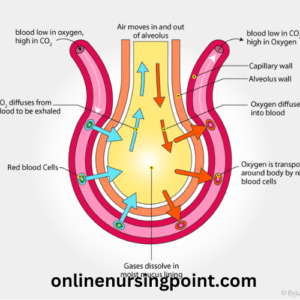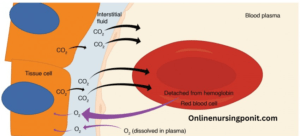Respiration & Breathing :-
BREATHING :-
Principal:- Air always moves from High Pressure to Low Pressure
Their are two types of breathing :-
1. Inhalation (Inspiration)
2. Exhalation (Expiration)
Inhalation :-
Inhalation is represent (U,F,O) .
U:- Upward
F:- Forward
O:- Outward
The contraction of Inter coastal muscles will be done.
During Inhalation the Diaphragm was also play an important role in Breathing . During Inhalation the diaphragm will flate because they support to the Inhalation. Ribs and sternum raised and they represent (U.F.O.= Upward, Forward and Outward.)
When we Inhale then the Diaphragm will move downward because we want to increase volume inside the thoraic cavity
When we Inhale then the volume of Thoraic Cavity will be increase.
When we Inhale then the Pressure of Thoracic cavity will be decrease as compare to the outermost atmosphere.
Exhalation :-
IN the Exhalation is Ribs moves in the form of (D.B.I.)
D:- Downward
B:- Backward
I:- Inward
During Expiration the ribs and sternum moves/returned to original position and then the Volume of thorax decreased.
When the Ribs and Sternum will become their original position/shape then the volume of thorax will be decreased and then the air expelled from lungs.
The inter coastal muscles will be relax when the Ribs come out their original position.
When we Exhale then the Diaphragm will move downward Ribs will move inward. Then the diaphragm becomes their original shape they become in the dome shape. When the diaphragm becomes dome shape then air come out side then we can easily Exhalation process and alveoli will contract during this process.
FORCEFUL BREATHING :-
Structure involves in forceful breathing.
- Ribs
- External (Inter Coastal Muscles)
- Diaphragm
- Internal (Inter Coastal Muscles)
- Abdominal Muscles
PULMONARY VOLUMES AND CAPACITIES :-
1. Tidal Volume(T.V.):- Volume of air inspired or expired during a normal respiration(volume of air renewed in the respiratory system during each breathing). 500 ml
2. Inspiratory reserve volume (I.R.V.) or complemental air :- Additional volume of air, that can inspire by forceful inspiration. 2500-3000 ml
3. Expiratory reserve volume(E.V.R.) or supplemental air :- Additional volume of air, that can expire by a forceful expiration. 1000-1100 ml
4. Residal volume(R.V.) :- Volume of air remaining in the lungs after a forcible expiration. 1100-1200 ml
PULMONARY CAPACITIES :-
1. Inspiration Capacity (I.C.) [T.V.+I.R.V.] :- Volume of air that can inspire after a normal expiration. 3000-3500 ml volume
2. Expiration Capacity (E.C.)[T.V.+E.R.V.] :- Volume of air that can expire after a normal inspiration. 1500 – 1600 ml volume
3. Functional Residual Capacity(F.R.C.) :- Volume of air that will remain in the lungs after a normal expiration [E.R.V.+R.V.]. 2100 – 2300 ml volume
4. Vital Capacity (V.C.)[E.R.V.+T.V.+I.R.V.] :- Maximum volume of air that can breath in after a forced expiration or maximum volume of air that can breath out after a forced inspiration. 3500 – 4500 ml volume
5. Total Lung Capacity(T.L.C.) :- Total volume of air lungs after a maximum inspiration.[R.V. + E.R.V. + T.V. + I.R.V. or V.C. + R.V.] 5000 – 6000 ml volume
REGULATION OF BREATHING/RESPIRATION :-
- Nervous:- The parts of brain which can help to breath
1. Pons Varolhi:- In the pons varolhi their are two parts :-
I). Pneumotoxic Centre :- It is the switch off centre of the inhalation and inspiration .
II). Apnestic Centre :- It is responsible for modulating the depth and rhythm of breathing.
2. Medulla Oblongata:- In the Medulla Oblongata is also two parts:-
I). Dorsal Inspiratory Group :- They also control inspiration they control that how many time we will done inspiration.
II). Ventra Respiratory/Respiration Group :- They control both inspiration and expiration.
CHEMICAL :-
Their are two chemical which can help to regulate the breathing
- CO2(Carbon Dioxide )
- H+ Ions
- When the number of CO2 ions is more and H+ ions is also more than the rate of breathing rate that will be also more.
- When the number of CO2 ions is less and H+ ions is also less than the rate of breathing rate that will be also less.
- If their is no CO2 molecules than their no breathing can be done.
MECHANICAL :-
( Hering – Breur’s Reflex)
-
- Inhalation
- Bronchi and Bronchioles Stretch
- Strech receptors in their wall’s send impulse to brain
- Brain send’s message to stop inhalation and start exhalation.
GASEOUS EXCHANGE/INTERNAL RESPIRATION :-
Gaseous Exchange mainly depend’s upon
1. Pressure / concentration gradient ( High Pressure to Low Pressure).
2. Solubility of gases.
3. Thickness of membranes.
4. Surface area of repiratory membrane.
GAS EXCHANGE BETWEEN ALVEOLI & BLOOD OR BLOOD TISSUE :-
ALVEOLI AND BLOOD :-
The gaseous exchange between Alveoli and blood the air gaseous exchange always moves from high pressure to low pressure
- In Alveoli the pressure of oxygen (O2) is 104 mm/hg and the pressure of carbon dioxide (Co2) in Alveoli is 40 mm/hg and the pressure of (O2) oxygen in Blood is 40 mm/hg and the pressure of CO2 (carbon dioxide) in blood is 45 mm/hg
- Now the air moves from High Pressure to Low Pressure means air moves from Alveoli to the Blood
- Now the pressure of oxygen (O2) in Blood is 95 mm/hg and the prssure of carbon dioxide (Co2) in blood is 40 mm/hg.

BLOOD & TISSUE :-
The gaseous exchange between Blood to Tissue the air gaseous exchange always moves from high pressure to low pressure
- In Blood the pressure of oxygen (O2) is 95 mm/hg and the pressure of carbon dioxide (Co2) in Tissue is 40 mm/hg and the pressure of (O2) oxygen in Tissue is 20 mm/hg and the pressure of CO2 (carbon dioxide) in Tissue is 45 mm/hg
- Now the air moves from High Pressure to Low Pressure means air moves from Blood to the Tissue.
- Now the pressure of oxygen (O2) in Tissue is depends on the tissue it’s range is (20 to40) mm/hg and the pressure of carbon dioxide (Co2) in Tissue is also depends on the Tissue the range will be (45 to 48) mm/hg .

RESPIRATION GASES O2 CO2
Attmospheric air (inspired air) 159 0.3
Expired Air 116 32
Alveoli Air 104 40
Blood De-oxygenated 40 45
Blood Oxygenated 95 40
Tissue 40 45
